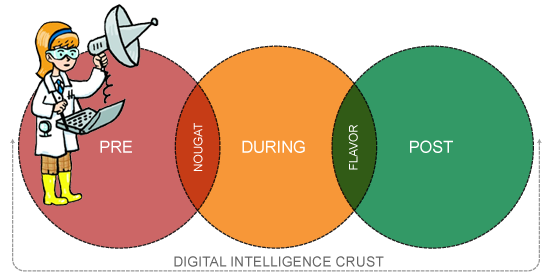Non-linear Routes of Contemporary Campaigns
WARNING! - If you don't live in the haus of marketing I'd respectfully advise you skip this post because it will bore you to tears. Ahhhh, guilt free.
Remember that thing you keep talking about in meetings but you never do?
No – I’m not talking about doing more cardio. Although that’s not a bad idea.
It’s that other thing. The one you know is super-important and could potentially change your business, but you just don't have time to learn about it. And you certainly don't have the budget to hire for it.

I’m talking about campaign optimization.
Yeah, baby! That’s right. It’s finally time to do something with that amazing data piling up all around you. You have Facebook insights, Twitter statistics, Google analytics, and myriad other numbers that mean absolutely nothing to most people. But in the right hands, they offer a killer advantage.
Most of us know these numbers are necessary to prove that our efforts are worthwhile. But what you DO with them?
Real-time optimization
What the contemporary marketer needs to understand is that no campaign moves seamlessly from A to Z. In fact, most campaign outlines will look like a maze by the time you're done. That’s because advertisers no longer push messaging in a linear fashion.
We start with a story or series of stories that are rolled out to the audience. As the campaign picks up momentum, we use social engagement to determine whether or not the messaging is doing its job.
Some members of your audience make it easy because they choose to engage with you deliberately. But the majority won’t interact.
That is where analytics come in.
We’ve entered an era in which all integrated marketing must involve real-time optimization of budgets and conceptual deployment. It's not enough to simply base media spend on a specific schedule. There are open-ended caveats based upon analytical intelligence. And the future of all advertising agencies, digital firms, social media consulting, and related services is bound by how they use the available data.
Just as you would look at a campaign in “pre, during and post” scenarios, the same should be said of how you to use your intelligence.
Pre Campaign:
I assume you already know that you need proper goals, measurement tools and robust storytelling in order for a campaign to succeed. In addition, look at things like demographics and geographical deployment, and do your due diligence regarding the social channels most popular with your audience.
Note: Start each campaign by considering all your social numbers to be zero. Don't start patting yourself on the back simply because you took 5000 followers to 5,500 followers.
Knowing the conceptual campaign will eventually go in an unforeseen direction, it's important to have a map of deployment efforts. Sure, the plan might change – but make some assumptions to start with. Then you can budget properly, and assess what you intend to do with your audience base. Think of this more like a media plan with the addition of design, deployment, engagement and other relevant factors that you will put in an integrated campaign.
During Campaign:
Once you start making traction with your audience, it's time to assign fractional benchmarks within the campaign. For instance, you may release video content or a micro-site, and analyze them to see if the audience is digesting the storyline as you intended. Look for things like increased conversation, trending topics, increased site traffic, and sentiment change against the brand.
Note: Consider running a “rogue campaign” parallel with your primary campaign as a testing option. This campaign is lean and has a smaller budget. It contains a unique conceptual thread and provides the flexibility to test alternative media locations. It is a testing tool that might reveal new channels.
It's safe to say you should progressively tier your testing after launch. I recommend breaks at 7, 15, 30, 60, 90 and 120 days. If you've not shifted budgets, tested alternative channels or run any A/B testing within that time, then you have not done an effective job for your client.
In addition to audience metrics, you should look at user interface, and user experience feedback with tools such as heat maps and click-tracking. This will give you a better understanding of the primary areas of focus for your user base. It's not enough to maximize your media spend within a campaign; you should progressively revamp your creative to maximize campaign effectiveness.
Post Campaign:
The last thing to consider in a campaign is perhaps the most important. And that's pulling as much data as possible to provide a barometer of how well you tactically took on the ebb and flow of your metrics.
The best thing you can do is follow the adage that, “If it's worth doing, it's worth testing.”
Don't believe the naysayers who say there's no defined ROI against digital and social mediums. Those people are unwilling to aggregate all the necessary data and make sense of it.
Stay on top of the latest trends. New metrics come online constantly, and they may or may not be helpful with a given campaign. It's just as important to progressively test against new metrics as it is to test new creative, storytelling, and engagement scenarios.
So how do you determine the success of your campaigns? What tools are you using? What do you, and your clients, feel is a proper measurement for success.
I would love to hear your feedback, and look forward to speaking with you.